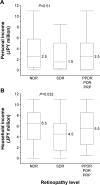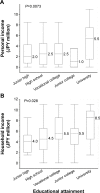A socioeconomic and behavioral survey of patients with difficult-to-control type 2 diabetes mellitus reveals an association between diabetic retinopathy and educational attainment
- PMID: 27822016
- PMCID: PMC5087708
- DOI: 10.2147/PPA.S116198
A socioeconomic and behavioral survey of patients with difficult-to-control type 2 diabetes mellitus reveals an association between diabetic retinopathy and educational attainment
Abstract
Background: We have recently reported that the attitude of patients toward risk could be a factor in the progression of diabetic complications. In general, risk preference is closely related to socioeconomic status (SES), which includes factors such as age, sex, income, and educational attainment.
Objective: We aimed to determine the effect of SES and behavioral propensity on the progress of diabetic complications in patients with type 2 diabetes mellitus (T2DM).
Methods: We conducted a survey of 238 patients with difficult-to-control T2DM treated at a hospital in Japan using a modified behavioral economics questionnaire that included questions related to SES. The patients had been referred by general practitioners or other departments in the hospital because of poor metabolic control or unstable complications.
Results: Educational attainment was significantly associated with progression of retinopathy in patients <65 years of age. Educational attainment of a high school diploma (12 years of education) or lower was a significant risk factor, but there were no differences among levels of attainment beyond high school (13-16 years or more of education). Behavioral propensities were also weakly associated with complications, but not as much as educational attainment. Personal income level and economic status did not show an association with the retinopathy levels.
Conclusion: Lower educational attainment is a strong risk factor for diabetic retinopathy, and it is independent of the economic status. The result suggests that cognitive function may play an important role in the progression of diabetic retinopathy in patients with T2DM.
Keywords: behavioral economics; cognitive function; diabetic nephropathy; economic status; income.
Conflict of interest statement
The authors report no conflicts of interest in this work.
Figures



Similar articles
-
A pathway from low socioeconomic status to dementia in Japan: results from the Toyama dementia survey.BMC Geriatr. 2018 Apr 27;18(1):102. doi: 10.1186/s12877-018-0791-6. BMC Geriatr. 2018. PMID: 29703157 Free PMC article.
-
Socioeconomic status and type 2 diabetes complications among young adult patients in Japan.PLoS One. 2017 Apr 24;12(4):e0176087. doi: 10.1371/journal.pone.0176087. eCollection 2017. PLoS One. 2017. PMID: 28437472 Free PMC article.
-
The pathways from parental and neighbourhood socioeconomic status to adolescent educational attainment: An examination of the role of cognitive ability, teacher assessment, and educational expectations.PLoS One. 2019 May 22;14(5):e0216803. doi: 10.1371/journal.pone.0216803. eCollection 2019. PLoS One. 2019. PMID: 31116770 Free PMC article. Clinical Trial.
-
Behavioral economics survey of patients with type 1 and type 2 diabetes.Patient Prefer Adherence. 2015 May 11;9:649-58. doi: 10.2147/PPA.S82022. eCollection 2015. Patient Prefer Adherence. 2015. PMID: 25999700 Free PMC article.
-
Sex differences in micro- and macro-vascular complications of diabetes mellitus.Clin Sci (Lond). 2017 May 1;131(9):833-846. doi: 10.1042/CS20160998. Clin Sci (Lond). 2017. PMID: 28424377 Review.
Cited by
-
Diabetic Retinopathy Disease Burden in Patients With Lower Household Incomes vs Higher Household Incomes.J Vitreoretin Dis. 2025 Jan 7:24741264241309683. doi: 10.1177/24741264241309683. Online ahead of print. J Vitreoretin Dis. 2025. PMID: 39790837 Free PMC article.
-
Physical Activity Reduces the Risk of Developing Diabetes and Diabetes Medication Use.Healthcare (Basel). 2022 Dec 8;10(12):2479. doi: 10.3390/healthcare10122479. Healthcare (Basel). 2022. PMID: 36554003 Free PMC article.
-
Utilization patterns of insulin for patients with type 2 diabetes from national health insurance claims data in South Korea.PLoS One. 2019 Mar 6;14(3):e0210159. doi: 10.1371/journal.pone.0210159. eCollection 2019. PLoS One. 2019. PMID: 30840630 Free PMC article.
-
Time and risk preferences and the perceived effectiveness of incentives to comply with diabetic retinopathy screening among older adults with type 2 diabetes.Front Psychol. 2023 Apr 17;14:1101909. doi: 10.3389/fpsyg.2023.1101909. eCollection 2023. Front Psychol. 2023. PMID: 37138986 Free PMC article.
-
Irrational Responses to Risk Preference Questionnaires by Patients with Diabetes with or without Retinopathy and Comparison with Those without Diabetes.Diabetes Metab Syndr Obes. 2020 Dec 14;13:4961-4971. doi: 10.2147/DMSO.S283591. eCollection 2020. Diabetes Metab Syndr Obes. 2020. PMID: 33376369 Free PMC article.
References
-
- Inzucchi SE, Bergenstal RM, Buse JB, et al. Management of hyperglycaemia in type 2 diabetes, 2015: a patient-centred approach. Update to a position statement of the American Diabetes Association and the European Association for the study of diabetes. Diabetologia. 2015;58(3):429–442. - PubMed
-
- Group TDCaCTR The effect of intensive treatment of diabetes on the development and progression of long-term complications in insulin-dependent diabetes mellitus. N Engl J Med. 1993;329(14):977–986. - PubMed
-
- Group UPDSU Intensive blood-glucose control with sulphonylureas or insulin compared with conventional treatment and risk of complications in patients with type 2 diabetes (UKPDS 33) Lancet. 1998;352(9131):837–853. - PubMed
-
- Zhao G, Ford ES, Li C, Mokdad AH. Compliance with physical activity recommendations in US adults with diabetes. Diabet Med. 2008;25(2):221–227. - PubMed
-
- Nelson KM, Reiber G, Boyko EJ. Diet and exercise among adults with type 2 diabetes: findings from the third national health and nutrition examination survey (NHANES III) Diabetes Care. 2002;25(10):1722–1728. - PubMed
LinkOut - more resources
Full Text Sources
Other Literature Sources

